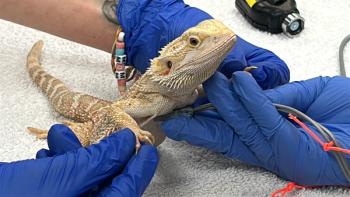
Emergency medicine in birds (Proceedings)
This lecture will provide an overview of emergency management of critical avian patients by addressing emergency preparedness, supportive care, empirical drug therapy (e.g. antibiotics and supplements), nutritional support, oxygen therapy and oxygen therapy
This lecture will provide an overview of emergency management of critical avian patients by addressing emergency preparedness, supportive care, empirical drug therapy (e.g. antibiotics and supplements), nutritional support, oxygen therapy and oxygen therapy
Initial Consideratons
Preparation—Preparation for an avian emergency begins well before the patient arrives. Remember the 5 Ps—Proper Preparation Prevents Poor Performance or Proper Preparation Provides for Peak Performance (Jones 2007). The veterinary team should prepare the following prior to the patient's arrival: warm fluids, a warm (and humidified) environment/cage, an anesthetic machine ready to provide oxygen/anesthetic support and a "crash cart" with emergency drugs and necessary supplies. Assess the patient (visually/physically) on arrival, then placed the bird in the supportive care enclosure in a quiet area. During the visual examination note the patient's posture, respiratory character and degree of alertness and manage problems that require immediate attention (i.e. cardiopulmonary arrest, active hemorrhaging, respiratory distress, external coaptation of fractures). If the patient presents in cardiopulmonary arrest then the ABCs of cardiopulmonarys resuscitation (now referred to as cardiopulmonary-cerebral resuscitation [CPCR])) should be immediately instituted.1 The clinician should calmly delegate responsibilities to the veterinary team including asking someone to make a record of all CPR activity.
Airway—Establish and maintain an open airway via endotracheal intubation or an air sac cannula;
Breathing—Provide positive pressure ventilation manually or use a appropriately sized small animal ventilator
Circulation—Maintain circulation with cardiac compressions as well and fluid expansion.
Appropriate drugs for CPR include epinephrine (1:1,000; 0.5-1.0ml/kg IT, IV, IC or IO), Atropine—0.5 mg/kg IM, IV, IO, IT and doxapram HCL (5-10 mg/kg once IM, IV or SC.2 The prognosis for successful CPR is very poor owning to the anatomy of birds and the ability to perform adequate "chest" compression; however, every effort should be made to resuscitate a patient unless the owner/agent declines resuscitative efforts.
Diagnostic And Therapeutic Plan
The next step in successful case management is to develop a diagnostic and therapeutic plan as quickly as possible. Making a plan serves to coordinate and focus your thoughts for the benefit of the patient. Once the patient is made comfortable or stabilized in as stress free of an environment as possible it is imperative to get a complete history of the problem as well as notify the owner of the patient's prognosis and obtain informed consent for further treatment. Once a plan is developed and other initial steps are completed then reassess the patient. If the patient is stable perform a physical examination, provide supportive care as needed, obtain samples for appropriate primary and ancillary diagnostic tests, administer appropriate empirical drug therapy and provide analgesia and nutritional support. The order of those events may vary depending upon the clinical situation. In some instances it may be more prudent to minimize handling, provide supportive care and forgo diagnostic testing for a time until the patient more stable. Remember that no procedure is more important than the patient unless that procedure is necessary to save the patient's life.
Physical Examination—A physical exam may be performed on the patient depending upon the initial assessment, the severity of disease, and whether the patient is able to tolerate some degree of stress. In some cases I have an anesthetic machine set up and ready before removing the bird from its enclosure. The physical exam should be quick and with a specific goal in mind. Remember to perform only those procedures that are determined to be necessary to evaluate the patient and begin appropriate therapy. Above all else minimize handling of the sick patient and Do No Harm! If necessary perform a brief physical exam as you are transferring the patient into its cage.
From the initial assessment the clinician should be able to develop a working list of differential diagnoses and further develop the initial diagnostic and treatment plan. If the patient can tolerate venipuncture attempt to get a minimum data base including a full complete blood count (CBC) biochemical panel. In many instances a blood smear/estimated white blood cell count and leukocyte differential, packed cell volume (PCV)/total protein, glucose, uric acid, Aspartate aminotransferase (AST) and calcium may help define the patients condition and disease process. Additionally diagnostics that may be indicated include an ophthalmic exam, cytology (Gram's stain of the feces or DiffQuick stain of body fluids), bile acids and radiographs (with or without anesthesia).
Fluid therapy—When planning fluid therapy always take into account blood loss, dehydration and shock. Blood loss or volume depletion can result from a variety of disease conditions such as blood feather damage, trauma, GI bleeding, and/or bone marrow suppression. Likewise, dehydration and shock can result from not only hemorrhage or trauma but from a multitude of acute or chronic systemic illnesses. Dehydration results from decreased fluid intake or increased fluid losses with or without the presence of systemic illness.1 Shock is the clinical state resulting from an inadequate supply of oxygen to tissues or the inability of the tissues to properly utilize oxygen and shock may result from hypovolemia, hypoxemia, septicemia/endotoxemia, trauma, anesthesia, anaphylaxis, cardiac disease/failure, systemic illness, etc.2 Patients in or at high risk of shock may benefit from large volume fluid expansion. An IV bolus of fluids (10 ml/kg slowly) to maintain blood pressure, circulation and oxygenation of peripheral tissues is well tolerated in birds with few untoward effects (e.g. pulmonary edema, coughing, dyspnea, ascites, polyuria, diarrhea, and relative anemia).1
Assessing Hydration Status—Estimate hydration status using the signalment (dehydration is more severe in juvenile birds) presenting clinical signs, history and physical examination. Turgescence, filling time and luminal volume of the basilic artery and vein, skin turgor on the dorsal aspect of the feet, sunken appearance to the eyes, tacky mucous membranes, decreased skin elasticity on the dorsal aspect of the metatarsus, and increased heart rate are findings that suggest dehydration to varying degrees. An objective method for assessing hydration status is to obtain a PCV and total protein. It is reasonable to suggest that most critically ill patients are dehydrated to some degree and possibly hypovolemic. In most instances mild to moderately ill birds are assumed to be approximately 5 % dehydrated while severely ill birds are assumed to be approximately 8-10% (or greater) dehydrated.
Fluid Administration—The goal of fluid therapy should be to replace fluid deficits and maintain hydration status as the patient recuperates. Fluids should always be warmed (~104 °F) prior to administration. The daily maintenance fluid requirements for birds has been estimated at 50-60 ml/kg/day (depending upon the species). The fluid deficit is calculated by multiplying the normal body weight in grams by the estimated percent of dehydration to obtain the milliliters of fluid required. The deficit should then be replaced over 24 hours (or sooner) while maintenance requirements are met at the same time. The clinician should also take into account ongoing fluid losses when determining fluid requirements. Hetastarch (10-15ml IV or IO slowly every 6-8 hours for 1-4 treatments) in conjunction with isotonic crystalloids ( the volume is reduced to 40-60% of normal requirements) is recommended for the treatment of hypovolemia when plasma volume expansion is desired.1 Hetastarch is contraindicated in patients with anuric or oliguric renal disease not associated with hypovolemia, congestive heart failure or in any situation where volume overload is a potential problem.
Calculation of Fluid Requirements—Example: Yellow-naped Amazon parrot
Normal weight = 500 g, estimate 8% dehydrated and with diarrhea:
Maintenance fluid required = 50 ml/kg x 0.5 kg = 25 ml; replace in first 24 hours or sooner
Fluid deficit = 500 g x 0.08 = 40 ml; deficit replaced in first 24 hours
Ongoing losses (2%) = 500g x 0.02 = 10ml; replace in first 24 hours
Routes of Fluid Administration—Fluids may be given intravenously, intraosseously, orally, and subcutaneously. The route of fluid administration should be based upon the clinical disorder, its severity and duration. Oral fluid therapy is useful for patients that are mildly dehydrated. Advantages include ease of rapid administration and low cost. However, fluids given this route tend to absorb slowly and are not appropriate for patients with gastrointestinal disorders, sudden or marked fluid loss, CNS disease or inability to stand. Subcutaneous fluids are also quick and easy to administer. However, this route is not recommended for moderately or severely dehydrated patients, because peripheral vasoconstriction may significantly reduce absorption, and only non-irritating isotonic fluids are appropriate. Sites for subcutaneous administration include the inguinal (inguen) region and interscapular regions. Intravenous and intraosseous (IO) routes are the preferred route when fluid loss is severe or sudden. Advantages of these routes are that they are fast, precise, and allow the use of hypertonic fluids. Disadvantages are time limitations, pain (IO) and available catheter sites and other complications (phlebitis, thrombophlebitis, local infection and removal by the patient) Sites for intravenous fluid administration include the jugular veins, basilic veins, and the medial metatarsal veins. Sites for intraosseous administration include the distal ulna and the proximal tibiotarsus.
Fluid Choice—The fluid of choice is one that best approximates the fluid lost; this most often is Lactated Ringer's Solution (LRS) or Normosol-R with or without dextrose (2.5%). Repeated assessment of the patient following fluid administration should include a physical examination (assess hydrations status), auscultation of the heart and lungs, PCV and total protein and the patient's weight.
Empirical drug therapy—Empirical therapy should be considered for any avian emergency case. Most commonly antibiotics are used to treat primary and secondary bacterial infections and antifungal agents are indicated when a fungal etiology (i.e. aspergillosis) is suspected. In debilitated patients the clinician may assume that the patient's immune system is compromised and choose parenteral bactericidal antimicrobials such as ticarcillin, piperacillin, ceftazidime, ceftiofur, enrofloxacin, and trimethoprim-sulfamethoxazole. Bacteriostatic antibiotics include chloramphenicol and doxycycline. When giving empirical medications the parenteral routes (IM, IV or IO) are preferred in emergency situations due to the more rapid rates of absorption. Subcutaneous and oral routes are reserved for maintenance therapy or patients whose size dictates the use of these methods.
Nutritional supplements—Patients which are anemic may require Vitamin B Complex (1-3 mg thiamine/kg, weekly) and iron dextran therapy (10 mg/kg, repeat in 7-10 days).2 Patients with nutritional diseases may require Vitamin A and D3 supplementation (0.1 mg/300 g body wt. Once weekly).1 Birds with neuromuscular diseases may benefit from supplementation with Vitamin E/Selenium (0.05 to 0.1 gm/kg IM, every 14 days) or Calcium.1
Corticosteroids—Corticosteroid administration for the treatment of shock remains controversial. Beneficial effects of corticosteroid administration are improved capillary membrane integrity, stabilization of lysosomal membranes, improved tissue perfusion and microcirculation, and gluconeogenesis. For optimum effect, water soluble drugs, such as dexamethasone (2 mg/kg) and prednisolone sodium succinate (2-4 mg/kg) should be given IM or preferably IV for the first 24-48 hours. Because of the potential for increasing incidence of infection due to immunosuppression, corticosteroids are recommended only if indicated and for a very short term. They are no longer recommended in cases of head trauma or in patients suspected of having an infectious disease.
Analgesia
Regardless of the severely of disease analgesia should always be considered in any critically ill patient; especially if the illness is related trauma. In our practice meloxicam (0.1-0.2 mg/kg PO or IM q 24 hours) is commonly used for its analgesic anti-inflammatory effects.1 Opioids such as butorphanol (0.4-2.0 mg/kg IM) are also commonly used; especially to provide perioperative analgesia).1
Blood Transfusions
Blood transfusions appear to be useful in patients with a PCV of 20% or less. Homologous transfusions are preferable to heterologous transfusion although single heterologous transfusions have been successful,4,5 The transfusion volume should roughly be 10-20% of calculated blood volume of the recipient.5 An appropriate volume of blood is taken from the donor and placed in Anticoagulant citrose dextrose (ACD) (ACD solution, Formulation A, Baxter Health Care Corp, Deerfield, IL) at a rate of 0.15 ml of ACD per milliliter of blood.4 If a donor is not available Oxyglobin may be given intravenously as a rapid bolus (5m/kgO over a few minutes).1 Reportedly, oxyglobin is up to 10 times more effective than blood when given during fluid resuscitation to animals in hemorrhagic shock.1 Unfortunately, oxyglobin is quite expensive, may not be readily available and must be discarded within 24 hours due to the production methemoglobin.1
Nutritional Support
There is a tremendous relationship between poor nutrition and immunosuppression. Therefore, nutritional support must be taken very seriously in critically ill or starving patients.6 And, it is important to differentiate between these two conditions. Malnourished (starving) patients are in a hypometabolic state while critically ill patients are often in a hypermetabolic state.6 Because of their high metabolic rates (BMR), birds are unable to function on energy reserves for extended periods of time.6 Therefore, the aim of nutritional support is to provide a highly nutritious diet that is easily digestible, quickly absorbed and readily utilized by the patient. Many nutritional supplements are hyperosmolar and have a tendency to dehydrate the patient; therefore, close attention must be paid to the hydration status of any bird receiving such formulas. This is especially critical in carnivorous patients (raptors) that may develop "sour crop" if fed while still dehydrated. Routes of administration include enteral feeding (which uses the digestive tract and is the simplest) and parenteral feeding (which bypasses the digestive tract by supplying amino acids, fats, and carbohydrates directly into the vascular system).5 Methods of enteral feeding include the use of metal or rubber gavages tubes and esophagostomy, pharyngostomy, duodenostomy tubes. Commercial products commonly used in our practice include Lafebers and Kaytee's enteral nutrition products.
Calculating BMR—To calculate the Basal Metabolic Rate (BMR) use the following formula:
BMR = K x weight (Kg)0.75 where K= 129 (passerines, possibly psittacines) or K=78 (non-passerine species).
Ex: 500 g Amazon parrot with severe trauma would need BMR = 78 (0.5000.75 ) = 46.4 Kcal/day. Estimating MER as 1.5 times BMR, approximate MER = 1.5 x 46.4 Kcal/day = 69.5 Kcal/day. Severe trauma adjustment is 1.1 x 69.5 Kcal/day = 76.5 Kcal/day. If the caloric density of the enteral product is known, the exact amount can be determined.
Total parenteral nutrition involves the intravenous/intraosseous administration of essential nutrients including amino acids, lipids, carbohydrates, vitamins, electrolytes, and minerals. Indications for TPN include gastrointestinal stasis, regurgitation, gastrointestinal surgeries, severe head trauma, and diseases of malabsorption or maldigestion. Typically a 10% amino acid solution, a 20% lipid solution, and a 50% dextrose solution are used. The most serious complications include sepsis or bacteremia as a result of bacterial contamination of the catheter.
Refeeding syndrome—Refeeding syndrome is associated with metabolic/electrolyte disturbances that occur as a result of feeding a patient that has been starved or severely malnourished. This syndrome is associated with increases insulin release and often occurs within a few days of renourishment (especially carbohydrates). In psittacines and granivorous species glucagon may play more of an important role in carbohydrate metabolism. However, species such as raptors, in which insulin may be important for maintaining formal blood glucose levels, this syndrome may be a significant consequence of starvation. When patients are renourished increased insulin secretions results in increased intracellular uptake of glucose along with phosphorus and other electrolytes, namely potassium, magnesium and thiamine.7 This combined with already depleted electrolytes may lead to dangerously low levels of plasma phosphorous, potassium and magnesium.7 To combat this phenomenon plasma electrolytes should be monitored in critically ill patients and managed during fluid therapy.
Oxygen Therapy
Birds have a unique respiratory system which allows them to efficiently extract oxygen from the environment and withstand hypoxic episode better than mammals.5 Ultimately, adequate perfusion of tissues is necessary for oxygen therapy to be of any benefit. For example, birds that are severely anemic or in circulatory shock need adequate volume expansion and red blood cell replacement in order for improved tissue oxygenation to occur.5 Administration of oxygen via a face mask can be effective for short term use; however, an oxygen cage/enclosure should be considered standard equipment for any veterinary hospital or clinic.5 Oxygen can be supplemented at 100% for short periods of time (less than 12 hours)5 ; however 40% oxygen is standard and should be maintained
Nebulization with or without oxygen therapy is also beneficial in avian patients, especially those with respiratory tract disease. Nebulization may be used to administer medications such as antibiotics to patients with respiratory tract disease. However, nebulized drugs probably reach only 20% of lung tissue and the caudal thoracic and abdominal air sacs.5 The size of the particle nebulized dictates how far along the respiratory tract it will progress. Particles from 3 to 7 (m generally deposit in the trachea and mucosal surface of the nasal cavity, whereas particles less than 3 (M are needed to establish local drug levels in the lungs and air sacs.5 Saline is the nebulizing fluid preferred by most. When nebulizing medications dilute the systemic drug dose in 5-10 ml or saline and deliver over a 15-30 nebulization session.8
Temperature—Additional measures of supportive care include providing adequate warmth and a stress free environment. Most critically ill patients should be considered to be hypothermic. These patients will benefit greatly from an environment warmed to 85-90oF
References provided on request
Newsletter
From exam room tips to practice management insights, get trusted veterinary news delivered straight to your inbox—subscribe to dvm360.






